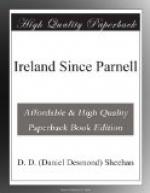The Gaelic League, founded in 1893 by a few enthusiastic Irish spirits, was formed to effect an Irish renascence in matters of the mind and spirit. It was non-sectarian and non-political. Its purpose was purely psychological and educational—it sought the preservation of the Irish language from a fast-threatening decay, it encouraged the study of ancient Irish literature and it promoted the cultivation of a modern literature in the Irish language. Its beginnings were modest, and its founders were practically three unknown young men whose only special equipment for leadership of a new movement were boundless enthusiasm and the possession of the scholastic temperament. Douglas Hyde, the son of a Protestant clergyman, dwelt far away in an unimportant parish in Connaught, and, while still a boy, became devoted to the study of the Irish language. Father O’Growney was a product of Maynooth culture, whose love of the Irish tongue became the best part of his nature, and John MacNeill (now so well known as a Sinn Fein leader) was born in Antrim, educated in a Belfast school and acquired his love for Irish in the Aran islands. It is marvellous to consider how the programme of the new League “caught on.” Some movements make their appeal to a class or a cult—to the young, the middle-aged or the old. But the Gaelic League, perhaps because of the very simplicity and directness of its objects, made an appeal to all. It numbered its adherents in every walk of life; it drew its membership from all political parties; it gathered the sects within its folds, and the greatest tribute that can be paid it is that it taught all its disciples a new way of looking at Ireland and gave them a new pride in their country. Ireland became national and independent in a sense it had not learnt before—it realised that “the essential mark of nationhood is the intellectual, social and moral patrimony which the past bequeaths to the present, which, amplified, or at least preserved, the present must bequeath to the future, and that it is this which makes the strength and individuality of a people.”
Its branches spread rapidly throughout Ireland, and the movement was taken up abroad with equal enthusiasm. Irish language classes were organised, Irish history of the native—as distinct from the British—brand was taught. Lessons in dancing and singing were given and the old national airs were revived and became the popular music of the day. It would take too much of my space to recount all the varied activities of the League, all that it did to preserve ancient Irish culture, to make the past live again in the lives of the people, to foster national sports and recreations, to organise Gaelic festivals of the kind that flourished in Ireland’s artistic past, to create an Irish Ireland and to arrest the decadence of manners and the Anglicisation which had almost eaten into the souls of the people and destroyed their true Celtic character. Mr P.H. Pearse truly




